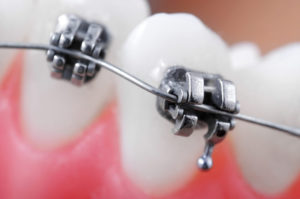
While walking through the woodland this morning, the dental elves were charmed by the cherry blossom and wisps of lambs’ wool hanging on branches. Ah, Spring has truly sprung!
Anyone who has ever had braces on their teeth will tell you that a similar effect can be seen in the mouth after eating a sandwich. So can we choose a brace that helps patients keep their teeth clean?
A recent systematic review conducted by a research team in Switzerland aims to find out by assessing the effects of different ligation methods on periodontal health in adolescent orthodontic patients with fixed braces. The review looked at different types of ligature (steel ligatures and elastomeric ligatures). Conventional brackets and self-ligating brackets were assessed in terms of plaque index, gingival index and probing depth.

The continued use of self-ligating brackets has been the source of some controversy in dental research and on academic blogs.
Methods
The reviewers carried out an appropriate (although not completely comprehensive) search of Medline, The Cochrane Library and the Cochrane Controlled Trials Register. They followed up reference lists and contacted authors directly to root out unpublished studies. They did not limit their search by language, although it’s unclear from the paper whether they actually included any non-English language studies in the review.
They used a random effects meta-analysis to assess a total of 8 trials (7 randomised controlled trial, 1 controlled clinical trial); most of which were fairly small studies (the minimum size allowed in the review was 10 participants). It’s unclear how many patients in total were included in the review.
The Cochrane risk of bias tool and GRADE criteria were used to assess the quality of the included studies. It’s fair to say that the application of GRADE in this instance was ‘generous’.
The included trials were a mix of parallel group and split mouth studies, with a wide variety of outcome measures. The reviewers conducted 4 separate meta-analyses on the evidence they found.
Results
- No clinically significant differences were found at 4-6 weeks or 3-6 months between conventional brackets and self-ligating brackets on plaque index, gingival index or pocket depth:
- Plaque index WMD (weighted mean difference) = 0.14 (0.00 to 0.28), 3 studies
- Gingival index WMD = 0.06 (-0.24 to 0.36), 2 studies
- Pocket Depth WMD = 0.01 (-0.12 to 0.14), 2 studies.

No clinically significant differences were found between conventional brackets and self-ligating brackets.
Conclusions
Overall, non-significant differences on the periodontal status of adolescents undergoing orthodontic treatment with either conventional or self-ligating brackets were detected.Clinical significance: The periodontal status of adolescents undergoing orthodontic treatment is of considerable importance. The synthesis of the available evidence on oral hygiene related factors will provide insights to best clinical practice during the course of orthodontic treatment.
Limitations
- Wire ligatures were used in the majority of studies included in this review, which doesn’t reflect UK clinical practice
- The included studies were very heterogeneous (a mix of parallel group and split mouth studies) and had a wide range of different outcomes, which makes pooling of the studies difficult
- The trials in this review were small and had very short follow-up (3-6 months). It’s likely that the best oral hygiene would occur in the short-term and that more problems might happen over longer periods. Orthodontic treatment is usually closer to 18 months, so longer follow-up would have significantly improved the quality of this review’s findings
- The risk of bias conducted by the reviewers found moderate to high risk of bias in 4 of the studies included in meta-analysis
- Blinding of clinicians and patients is not feasible in these studies.

Unfortunately this review doesn’t help us choose a brace to keep teeth clean. Here are some spring flowers to cheer you up!
Implications for practice
- In our view as a team of dentists working in the United Kingdom, this paper (focusing on wire ligatures) is not clinically relevant to the UK
- We can’t change clinical practice or inform patient choice with this evidence. If we are serious about proving the efficacy of self-ligating brackets, we need to conduct more focused research in this field, i.e. larger trials with longer follow-up
- The evidence on self-ligating brackets (SLBs) is (at best) inconclusive. It points to no difference between SLBs and conventional brackets
- It’s worth highlighting that we also need core outcome sets in dental research that are relevant to patients and professionals. One of the key methodological problems with this review was the heterogeneous set of included studies with a massive variety of outcomes. Developing a consistent way to measure outcomes in dental research will greatly facilitate the production of more evidence-based dental research.

Big thanks to the Scottish Dental Registrars for their blog contribution today!
Links
Primary paper
Arnold S, Koletsi D, Patcas R, Eliades T. (2016)The effect of bracket ligation on the periodontal status of adolescents undergoing orthodontic treatment. A systematic review and meta-analysis. J Dent. 2016 Nov;54:13-24. doi: 10.1016/j.jdent.2016.08.006. Epub 2016 Aug 18. [PubMed abstract]
